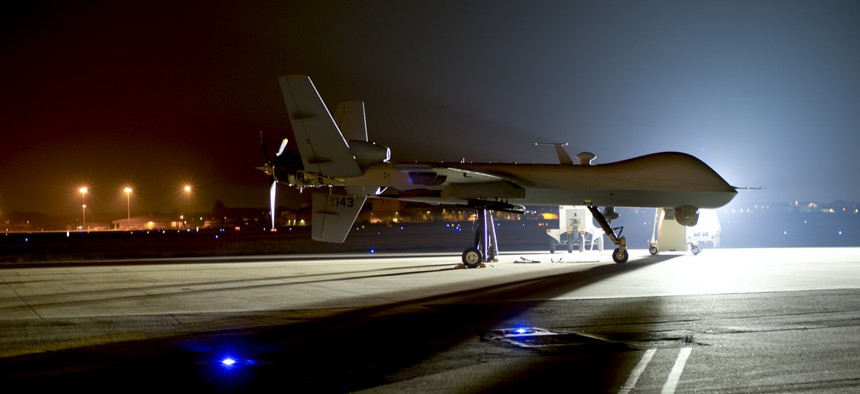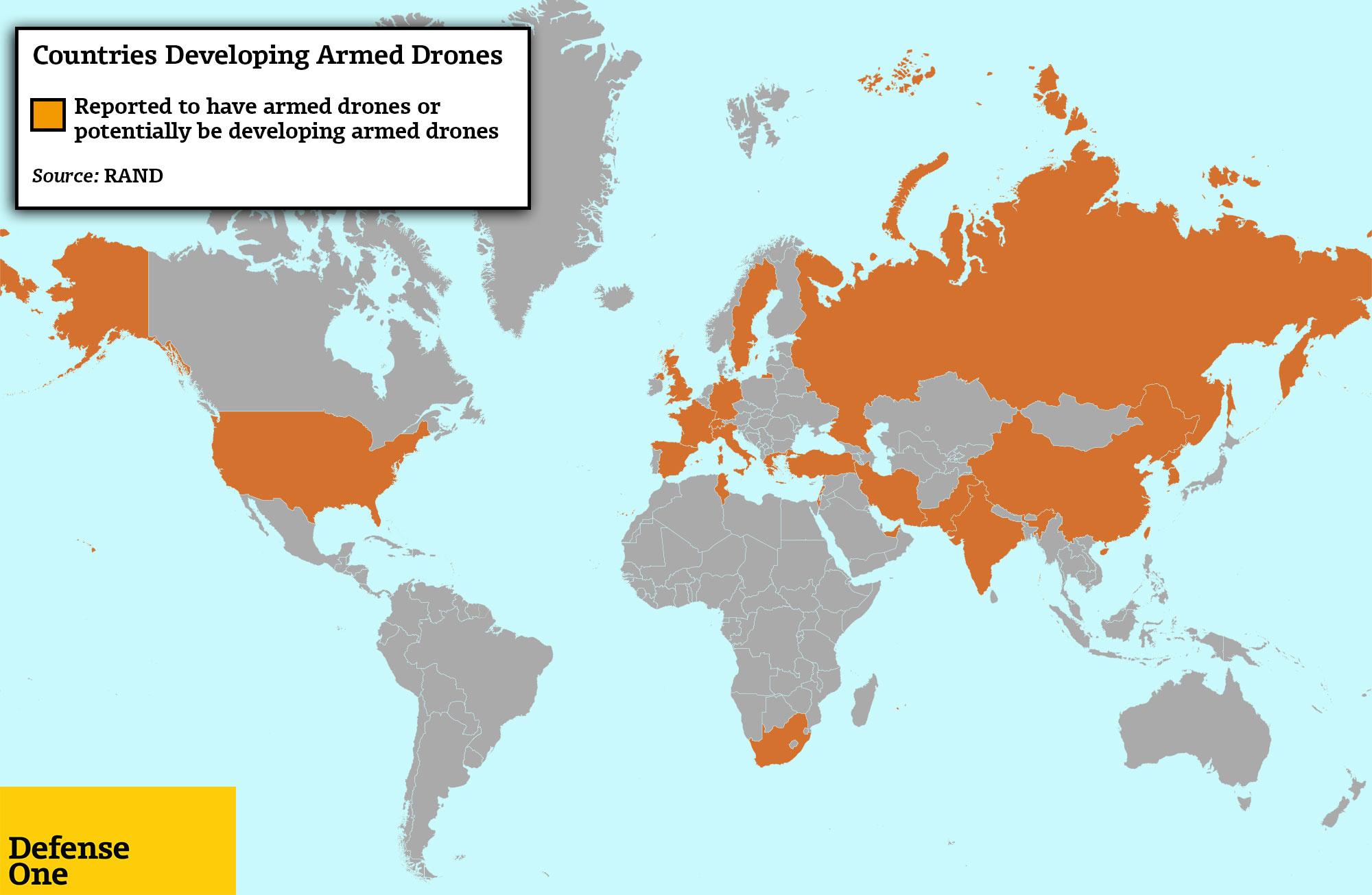
A U.S. Air Force MQ-9 Reaper drone on the flight line at Hurlburt Field, Fla., on April 24, 2014. U.S. Air Force photo by Staff Sgt. John Bainter
Pakistan Wants Drones and It Doesn't Need America's Permission to Get Them
There may be more cooperation between Pakistan and China than the Pakistani government admits. By Sara Sorcher
ISLAMABAD—From one breath to the next, Pakistani officials make the case for and against drone strikes. Ahsan Iqbal, Pakistan's minister of planning and development, for instance, calls American drone operations "very counterproductive." He says, "If they hit one target, they also bring collateral damage.... The whole tribe stands up, we get into more problems, and the U.S. gets bad publicity."
But, Iqbal offers, Pakistan "should have the technology to do it."
According to Islamabad's line of reasoning, if the Pakistani military or intelligence services were to carry out surgical strikes against extremists, the drones would become simply another tool for use in the country's own counterterrorism operations. That, Pakistani officials assert, would be more palatable to their people than a superpower continuing to kill their neighbors and family members from afar.
Unfortunately for Pakistan, the idea of giving top-notch armed drones to Islamabad has been a nonstarter among U.S. officials for years.
Unfortunately for the U.S., Islamabad doesn't need America's permission to get them.
Already, Pakistan has remote-piloted aircraft. Islamabad uses surveillance drones to provide the military with a real-time picture of its restive border areas or counterterrorism operations. Pakistan unveiled two new drones in November: Burraq, named after the winged horse from the heavens that transported Islamic prophets, and Shahpar. They were developed by Pakistan's defense industry, the government said, and would not be armed.
But several analysts note that the drones look conspicuously like China's Rainbow CH-3, which has been tested to carry and fire weapons. The resemblance (and apparently, a miniature model of the Burraq armed with missiles) has sparked speculation in defense circles that there may have been closer cooperation between Pakistan and China on the technology—and more potential for deadly use—than the Pakistani government admits.
Still, the extent of Pakistan's drones' capabilities is unknown, especially without pictures or video of the Burraq carrying a real weapon, says Douglas Barrie, a defense aerospace specialist at the London-based International Institute for Strategic Studies. "That said, it's not something countries would go out of their way to publicize, particularly Pakistan."
Pakistan's government has petitioned Washington for a moratorium on U.S. drone strikes. The complex politics mean that Pakistan might refrain from advertising its quest to arm its own drones. The Pakistani military did not respond to questions about the specific capabilities of its drones, and Sartaj Aziz, adviser to Pakistan's prime minister on national security, sidestepped when directly asked whether Pakistan wants its own armed unmanned fleet to take out extremists.
"I think our normal aircraft do it very well," Aziz says. "But [drone] technology is of course useful for weather-mapping; a number of other agriculture applications; remote sensing. We'd certainly like that technology. It's also very significant in the IT field."
More than 70 countries around the world have or are developing drones. The Rand think tank estimates that 23 countries either have developed or are developing an armed variety, Pakistan included. But the current supplier market remains tiny. That's because the technological leap required to get from a surveillance drone that flies using radio waves to a platform that can strike targets from a more remote location is so great. Indeed, only three countries are known to have armable drones on the market: the United States, Israel, and China.
The United States keeps a close hold on its exports. Only the United Kingdom flies armed U.S.-made drones, although Italy and France are said to be working on a deal to get them.
Israel, which has demonstrated its drone-strike capabilities in Palestinian-controlled territories and Lebanon, is the biggest seller around the world, according to a U.S. congressional source. But Israel is unlikely to sell weapons technology to Pakistan for a host of reasons, not least a reluctance to anger Washington or jeopardize its business with India.
This leaves China as Pakistan's most obvious partner. No surprise there: Pakistan works with China on fighter jets, so why not work together on unmanned aerial platforms?
Even China's armed-drone capabilities, however, are still technically unproven. Beijing has not yet publicly used its armed drones to strike targets, although at trade shows it has displayed vehicles capable of dropping bombs or missiles. Some look quite similar to U.S. drones, including a Predator knockoff that can be outfitted with laser-guided missiles similar to the Hellfire that Saudi Arabia recently snapped up.
By contrast, the American military has a cadre of proven operators who use a complex satellite system to control drones around the world, to strike targets thousands of miles away in places like Afghanistan, Pakistan, Somalia, and Yemen. Its aerial systems are integrated with ground operations so troops can call in air support and have a bomb drop where they want it to drop. Even if China continues investing heavily, it lacks the years of practice that the United States has in using armed drones in war zones.
But perhaps that doesn't matter for Pakistan. To target enemies inside its borders, Islamabad doesn't need the extra range from satellites.
Burraq, for instance, could fire laser-guided missiles, including ones from China, so long as it had a communications link to a ground-control station and skilled operators who could synthesize intelligence and mark the target. Pakistan could build relay stations to ensure that its drones don't lose signal in the mountainous northwest border region. "These are all things they could conceivably do, especially with Chinese help," the congressional source says. "We have no idea if they're doing it."
It's probably not a deal-breaker for a country like Pakistan if Chinese drones lack the ability to transmit information, or resolution, the way American-made models do. "The Chinese technology will be less advanced," Phil Finnegan, the director of corporate analysis for Teal Group, says. "But it's a big advance over not having the technology at all." Pakistan may actually get a better deal partnering with China to tailor still-developing technology to its desired range for lethal strikes, and custom-fit weapons it already has for drones.
Washington does not believe that Islamabad would use its military technology to target militants who threaten anything other than Pakistani interests. That's certainly one of the main reasons U.S. officials are reluctant to even consider selling armed drones to Pakistan.
But if Pakistan gets the technology from China, it will have even less incentive to target the militants it does not view as a direct threat.
Nations that buy U.S. drones rely on Washington for spare parts and software upgrades. Without any type of forced reliance, the divide between Pakistan and the United States could deepen—at a time when the U.S. troop drawdown in Afghanistan already complicates the logistics of carrying out unilateral American drone strikes in Pakistan.
Also, Pakistan's use of less precise Chinese technology could be risky—and not just for people in the strike zone. "If they fire, say, an AR-1 [Chinese missile], and it misses a target," says Haris Khan of the Pakistan Military Consortium think tank, "and it hits a house two blocks away, and people make a big fuss about it … they'll say, 'Uncle Sam did it.' There's always the question of blaming everything on the United States."

